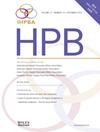Survival prediction for CA19-9 non-producers with resected pancreatic cancer
IF 2.4
3区 医学
Q2 GASTROENTEROLOGY & HEPATOLOGY
引用次数: 0
Abstract
Background
CA 19-9 is the most commonly used biomarker for pancreatic ductal adenocarcinoma (PDAC) but prognostication is a challenge for patients with normal CA 19-9 levels. We aimed to define most important prognostic factors for overall survival in PDAC patients with normal range CA 19-9 levels.
Methods
We performed a single-center retrospective review of PDAC patients with CA 19-9 level at diagnosis <37 U/mL who underwent curative intent resection. Cohort was divided into CA 19-9 non-producers (CA 19-9 level of <3 U/mL) and normal range CA 19-9 (between 3 U/mL and 37 U/mL). We used a multivariable Cox regression model to define the predictors of overall survival and constructed a nomogram.
Results
271 patients were included (75 CA 19-9 non-producers and 196 with normal range CA 19-9). Non-producers had worse overall survival (27.2 months versus 33.6 months) and higher rate of recurrence after resection. Predictors of survival were CA 19-9 level, age, sex, lymph node ratio, perineural invasion, surgical margin status and adjuvant chemotherapy.
Discussion
PDAC patients who are CA 19-9 non-producers have worse survival. Our findings highlight this high-risk subgroup, identify useful prognostic features and emphasize the ongoing need for improved biomarker development.
胰腺癌切除术后CA19-9非产生者的生存预测。
背景:CA 19-9是胰腺导管腺癌(PDAC)最常用的生物标志物,但对于CA 19-9水平正常的患者来说,预后是一个挑战。我们的目的是确定正常范围CA 19-9水平的PDAC患者总生存的最重要预后因素。方法:我们对诊断时CA 19-9水平的PDAC患者进行了单中心回顾性研究。结果:纳入271例患者(75例CA 19-9无产生,196例CA 19-9正常范围)。非生产者的总生存期较差(27.2个月对33.6个月),术后复发率较高。预测生存率的因素有CA 19-9水平、年龄、性别、淋巴结比例、神经周围浸润、手术切缘状况和辅助化疗。讨论:CA 19-9非生产者的PDAC患者生存率较差。我们的研究结果强调了这一高危亚组,确定了有用的预后特征,并强调了改进生物标志物开发的持续需求。
本文章由计算机程序翻译,如有差异,请以英文原文为准。
求助全文
约1分钟内获得全文
求助全文
来源期刊

Hpb
GASTROENTEROLOGY & HEPATOLOGY-SURGERY
CiteScore
5.60
自引率
3.40%
发文量
244
审稿时长
57 days
期刊介绍:
HPB is an international forum for clinical, scientific and educational communication.
Twelve issues a year bring the reader leading articles, expert reviews, original articles, images, editorials, and reader correspondence encompassing all aspects of benign and malignant hepatobiliary disease and its management. HPB features relevant aspects of clinical and translational research and practice.
Specific areas of interest include HPB diseases encountered globally by clinical practitioners in this specialist field of gastrointestinal surgery. The journal addresses the challenges faced in the management of cancer involving the liver, biliary system and pancreas. While surgical oncology represents a large part of HPB practice, submission of manuscripts relating to liver and pancreas transplantation, the treatment of benign conditions such as acute and chronic pancreatitis, and those relating to hepatobiliary infection and inflammation are also welcomed. There will be a focus on developing a multidisciplinary approach to diagnosis and treatment with endoscopic and laparoscopic approaches, radiological interventions and surgical techniques being strongly represented. HPB welcomes submission of manuscripts in all these areas and in scientific focused research that has clear clinical relevance to HPB surgical practice.
HPB aims to help its readers - surgeons, physicians, radiologists and basic scientists - to develop their knowledge and practice. HPB will be of interest to specialists involved in the management of hepatobiliary and pancreatic disease however will also inform those working in related fields.
Abstracted and Indexed in:
MEDLINE®
EMBASE
PubMed
Science Citation Index Expanded
Academic Search (EBSCO)
HPB is owned by the International Hepato-Pancreato-Biliary Association (IHPBA) and is also the official Journal of the American Hepato-Pancreato-Biliary Association (AHPBA), the Asian-Pacific Hepato Pancreatic Biliary Association (A-PHPBA) and the European-African Hepato-Pancreatic Biliary Association (E-AHPBA).
 求助内容:
求助内容: 应助结果提醒方式:
应助结果提醒方式:


